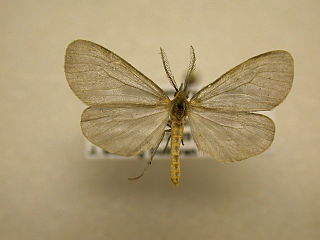
Pagara is a monotypic moth genus in the family Erebidae. Its only species, Pagara simplex, the mouse-colored lichen moth, is found in North America, where it has been recorded from Alabama, Arkansas, Florida, Georgia, Illinois, Indiana, Iowa, Kansas, Kentucky, Maryland, Mississippi, New Hampshire, North Carolina, Ohio, Oklahoma, South Carolina and Tennessee. Both the genus and species were described by Francis Walker in 1856.

Anomis erosa, the yellow scallop moth or abutilon moth, is a moth of the family Erebidae. The species was first described by Jacob Hübner in 1821. It is found in south-eastern North America. It is mostly a southern species, but migrants reach Manitoba, Quebec and Maine.
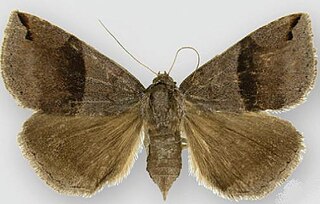
Gondysia similis, the gordonia darkwing is a moth of the family Noctuidae. The species was first described by Achille Guenée in 1852. It is found in the US from North Carolina to Mississippi and Florida. The food plant occurs in Alabama and Mississippi and the moth could be expected from these areas as well.

Monopis laevigella, the skin moth, is a species of tineoid moth. It belongs to the fungus moth family (Tineidae), and therein to the nominate subfamily Tineinae. It is the type species of the genus Monopis and its junior objective synonym Hyalospila. As with the common clothes moth, earlier authors frequently misapplied the name Tinea vestianella to the present species.

Macrochilo litophora, the angulate fan-foot or brown-lined owlet moth, is a litter moth of the family Erebidae. The species was first described by Augustus Radcliffe Grote in 1873. It is found in the United States from Wisconsin, east to Massachusetts, south to North Carolina, South Carolina, Mississippi and Texas.

Aethes smeathmanniana, or Smeathmann's aethes moth, is a moth of the family Tortricidae. It was described by Johan Christian Fabricius in 1781. It is found in most of Europe, Asia Minor and in North America, where it has been recorded from New Jersey and Newfoundland and Labrador.
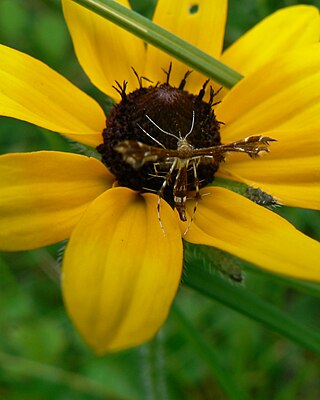
Geina tenuidactyla, the berry plume moth or Himmelman's plume moth, is a moth of the family Pterophoridae. The species was first described by Asa Fitch in 1854. It is found in North America, including Mississippi, Massachusetts, New York, Delaware, Maryland, West Virginia, Illinois, Ontario, Colorado, Nevada and California.
Hellinsia lacteodactylus is a moth of the family Pterophoridae described by Vactor Tousey Chambers in 1873. It is found in North America, including Florida, Mississippi, Kentucky, North Carolina, Colorado, Nova Scotia and British Columbia.

Oidaematophorus eupatorii, the eupatorium plume moth or Joe Pye plume moth, is a moth of the family Pterophoridae. It is found in North America, including Florida, Mississippi, Iowa, New York, California and Vancouver Island. It is also known from Mexico, Guatemala and Panama.

Stagmatophora wyattella, or Wyatt's stagmatophora moth, is a moth in the family Cosmopterigidae. The species was first described by William Barnes and August Busck in 1920. It is found in the US states of Maine, Ohio, Iowa, Kentucky, Michigan, Mississippi and Oklahoma.
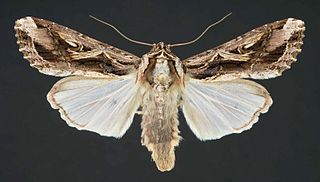
Spodoptera dolichos, the dolichos armyworm moth or sweetpotato armyworm moth, is a moth of the family Noctuidae. The species was first described by Johan Christian Fabricius in 1794. It is found from the southern United States, south through Costa Rica to South America, as far south as Argentina. In the United States, it may occur as far north as Kentucky and Maryland.
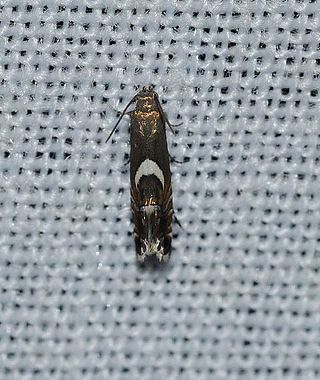
Diploschizia impigritella, the yellow nutsedge moth or the five-barred glyphipterid moth, is a species of sedge moth in the genus Diploschizia. It was described by James Brackenridge Clemens in 1862. It is found in North America, from Newfoundland to Florida, west to Texas and North Dakota. It has also been recorded from California.
Crambidia pura, the pure lichen moth, is a moth of the family Erebidae. It was described by William Barnes and James Halliday McDunnough in 1913. It is found in North America, including Arizona, Florida, Georgia, Kentucky, Maryland, Mississippi, New Jersey, North Carolina, Ohio, Ontario, South Carolina, Tennessee, Texas and Wisconsin.
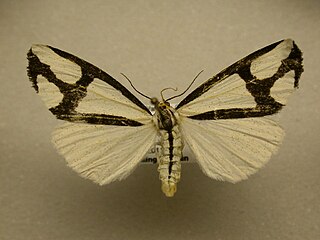
Haploa contigua, the neighbor moth, is a moth of the family Erebidae. It was described by Francis Walker in 1855. It is found in eastern North America, from Quebec to the mountains of Georgia and west to South Dakota, Arkansas and Mississippi.

David Adamski is an American entomologist working as a research associate at the Smithsonian Institution's National Museum of Natural History and a support scientist in the Systematic Entomology Laboratory (SEL), United States Department of Agriculture in Washington, D.C. He obtained a PhD degree from the Mississippi State University, Department of Entomology in 1987 after defending a dissertation, titled "The Morphology and evolution of North American Blastobasidae (Lepidoptera:Gelechioidea)". His research interests focus on alpha taxonomy, life histories and morphology of moths. Over the years, Adamski produced more than 80 scholarly publications, some in collaboration, shedding light on discernible groups of Lepidoptera including Gelechioidea, Tortricoidea, Pyralidoidea, and Noctuoidea. He studied divergent taxa within the Auchenorrhyncha and Sternorrhyncha, and Phytophagous Acari, as well as Gelechioidea and Blastobasidae. Adamski is a member of the Entomological Society of Washington.

Speranza is a genus of moths in the family Geometridae erected by John Curtis in 1828.

Diastictis argyralis, the white-spotted orange moth, is a moth in the family Crambidae. It was described by Jacob Hübner in 1818. It is found in North America, where it has been recorded from Colorado, Florida, Georgia, Indiana, Maine, Maryland, Mississippi, North Carolina, Ohio, Ontario, South Carolina, Tennessee, Texas and Virginia.

Agonopterix curvilineella, the curved-line agonopterix moth, is a species of moth in the family Depressariidae. It was first described by William Beutenmüller in 1889. It is found in North America, where it has been recorded from Illinois, Indiana, Kentucky, Maine, Maryland, Massachusetts, Michigan, Minnesota, Mississippi, New Brunswick, New York, Ohio, Ontario, Quebec, Tennessee, West Virginia and Wisconsin.
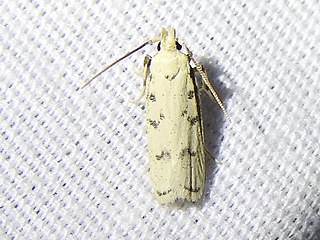
Glyphidocera lactiflosella, the five-spotted glyphidocera moth, is a moth in the family Autostichidae. It was described by Vactor Tousey Chambers in 1878. It is found in North America, where it has been recorded from Alabama, Arkansas, Florida, Georgia, Louisiana, Maine, Mississippi, North Carolina, South Carolina, Tennessee and Texas.

A MONA number, or Hodges number after Ronald W. Hodges, is part of a numbering system for North American moths found north of Mexico in the Continental United States and Canada, as well as the island of Greenland. Introduced in 1983 by Hodges through the publication of Check List of the Lepidoptera of America North of Mexico, the system began an ongoing numeration process in order to compile a list of the over 12,000 moths of North America north of Mexico. The system numbers moths within the same family close together for identification purposes. For example, the species Epimartyria auricrinella begins the numbering system at 0001 while Epimartyria pardella is numbered 0002.




















